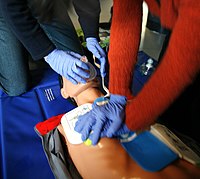
Photo from wikipedia
Abstract Peak respiratory exchange ratio is an objective marker of patient effort during cardiopulmonary exercise testing. We evaluated exercise variables in 175 adult congenital heart disease patients and the impact… Click to show full abstract
Abstract Peak respiratory exchange ratio is an objective marker of patient effort during cardiopulmonary exercise testing. We evaluated exercise variables in 175 adult congenital heart disease patients and the impact of respiratory exchange ratio on the prognostic value of exercise variables for short-term cardiac-related events. Of 175 patients, 110 completed the exercise test with a peak respiratory exchange ratio of ≥1.10 and the remaining 65 had a peak respiratory exchange ratio of <1.10. Peak oxygen consumption, the percentage of oxygen consumption at the ventilatory threshold, peak heart rate, percentage predicted peak heart rate, double product, oxygen uptake efficiency slope, and the number of patients with exercise oscillatory ventilation were reduced significantly in patients with a respiratory exchange ratio of <1.10 compared to those with a respiratory exchange ratio of ≥1.10. After a median follow-up of 21 months, total cardiac-related events occurred in 37 (21%) patients. Multivariate Cox proportional hazard analysis showed that the percentage predicted peak oxygen consumption, and oxygen uptake efficiency slope were independent predictors of cardiac-related events only in patients with a peak respiratory exchange ratio of ≥1.10. Sub-maximal exercise performance can be preserved in adult congenital heart disease patients. The percentage predicted oxygen consumption and the oxygen uptake efficiency slope are two independent predictors for short-term cardiac-related events in adult congenital heart disease patients.
Journal Title: Cardiology in the Young
Year Published: 2020
Link to full text (if available)
Share on Social Media: Sign Up to like & get
recommendations!